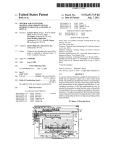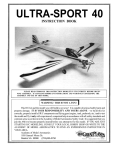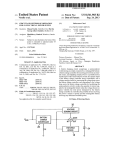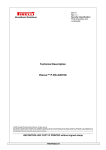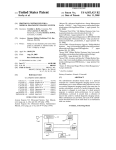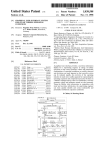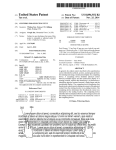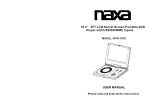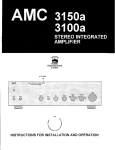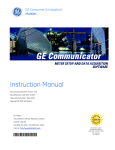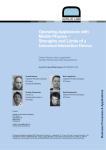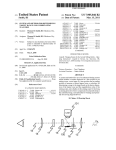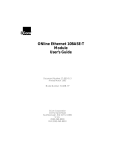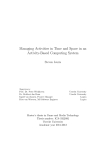Download System for organizing and visualizing display objects
Transcript
US008402382B2 (12) United States Patent (10) Patent N0.: (45) Date of Patent: Agarawala et a]. (54) (56) SYSTEM FOR ORGANIZING AND VISUALIZING DISPLAY OBJECTS US 8,402,382 B2 Mar. 19, 2013 References Cited U.S. PATENT DOCUMENTS (75) Inventors: Anand AgaraWala, Toronto (CA); Ravin Balakrishnan, Toronto (CA) 5,835,094 A * (73) Assignee: Google Inc., Mountain View, CA (US) Notice: 11/1998 Ermel et a1. 5,896,133 A 4/1999 Lynch et a1. 5,917,490 A * 6,243,724 B1 * 6/1999 6/2001 ................ .. 715/848 Kuzunuki et a1. ........... .. 715/775 Mander et a1. .............. .. 715/273 6,529,210 B1 3/2003 Rees 6,590,593 B1* 7/2003 6,608,628 B1 8/2003 Ross et a1. Robertson et a1. .......... .. 715/782 Subject to any disclaimer, the term of this patent is extended or adjusted under 35 6,618,063 B1 * 9/2003 7,509,588 B2 * 3/2009 Van Os et a1. .. U.S.C. 154(b) by 389 days. 7,532,196 B2 * 5/2009 Kurtenbach ................ .. 715/834 715/835 Hinckley .................... .. 345/156 (Continued) (21) Appl. No.: 12/293,198 FOREIGN PATENT DOCUMENTS (22) PCT Filed: Apr. 18, 2007 WO 2007121557 A1 11/2007 (86) PCT No.: PCT/CA2007/000637 Wu et al., “Multi-Finger and Whole Hand Gestural Interaction Tech (2), (4) Date: Apr. 24, 2009 OTHER PUBLICATIONS niques for Multi-user Tabletop Displays,” Proceedings of the 16th (87) Annual ACM Symposium on User Interface Software and Technol ogy: Vancouver, Canada, Nov. 2-5, 2003; [ACM Symposium on User Interface Software and Technology], NewYork, NY; ACM Press, vol. 5, No. 2, Nov. 2, 2003, pp. 193-202, 10 pp. PCT Pub. No.: WO2007/121557 PCT Pub. Date: Nov. 1, 2007 (65) (Continued) Primary Examiner * Kieu Vu Assistant Examiner * James T Durkin Prior Publication Data US 2009/0307623 A1 Dec. 10, 2009 (74) Attorney, Agent, or Firm * Shumaker & Sieffert, PA. Related US. Application Data (60) Provisional application No. 60/793,630, ?led on Apr. 21, 2006. (51) Int. Cl. G06F 3/048 G06F 3/033 (2006.01) (2006.01) (57) ABSTRACT A method, system and computer program for organizing and visualizing display objects within a virtual environment is provided. In one aspect, attributes of display objects de?ne the interaction between display objects according to pre determined rules, including rules simulating real world mechanics, thereby enabling enriched user interaction. The present invention further provides for the use of piles as an organizational entity for desktop objects. The present inven (52) US. Cl. ...... .. 715/765; 715/766; 715/847; 345/173; (58) Field of Classi?cation Search ................ .. 715/765, tion further provides for ?uid interaction techniques for com mitting actions on display objects in a virtual interface. A number of other interaction and visualization techniques are disclosed. 715/775, 808, 810, 848, 766, 847; 345/l73il79 See application ?le for complete search history. 19 Claims, 10 Drawing Sheets 345/ 179 US 8,402,382 B2 Page 2 5/2012 Davidson Wikipedia entry: Microsoft Bob, found at http://enWikipediaorg/W/ indeX.php?title:MicrosoftiBob&oldid?l8873217, Apr. 17, 2006, 2 US. PATENT DOCUMENTS 8,181,122 B2 2003/0074424 A1 4/2003 Giles et al. PP 2004/0021643 A1* 2/2004 2004/0117727 A1 6/2004 Wada Wikipedia entry: Magic Cap, found at http://en.Wikipedia.org/W/in deX.php?title:MagiciCap&oldid?l6961398, Apr. 4, 2006, 1 p. Hoshino et al. ............. .. 345/173 2005/0154991 A1* 7/2005 2006/0085767 A1* 4/2006 Hinckley eta. Jaeger ....... .. 2007/0064004 A1* 2007/0146347 A1* 3/2007 6/2007 2007/0192692 A1 2008/0168382 A1 8/2007 Chen et al. 7/2008 Louch et al. 2008/0168402 A1 7/2008 Blumenberg . 715/769 . 715/863 Bonner et al. . . 345/442 Rosenberg .................. .. 345/173 2008/0168403 A1 2008/0309632 A1 7/2008 Westerman et al. 12/2008 Westerman et al. 2009/0070705 A1 2009/0122018 A1 3/2009 Ording 5/2009 Vymenets et al. 2009/0228841 A1 2009/0307623 A1 2010/0079405 A1 9/2009 Hildreth 12/2009 Agarawala et al. 4/2010 Bernstein 2010/0211920 A1 8/2010 Westerman et al. OTHER PUBLICATIONS International Search Report and Written Opinion of application No. PCT/US2010/046688, mailed Dec. 22, 2010, 11 pp. International Search Report and Written Opinion of corresponding application No. PCT/CA2007/000637, mailed Aug. 16, 2007, 9 pp. Atwood, Coding Horroriprogramming and human factors, found at a. http://en.Wikipediaorg/Wiki/File:MagiciCapiOS. gif#?lehistory, May 25, 2006. 12 pp. Microsoft® BobTM version 1 for WindoWs®, found at http://Web. archive.org/Web/20060206205347/http://WWW.telecommander. com/pics/links/application%20softWare/microsoft/Microsofti BobflfO/MicrosoftfBobflfO.htm, Feb. 6, 2006, 2 pp. Resco Photo Viewer for S60, User Manual for v5 .0, accessed on Jun. 17, 2010, 18 pp. http://WWW.resco.net/symbian/doWnloads/ RescoVieWerS60.pdf. Of?ce Action fromU.S.Appl. No. 12/868,398, dated Oct. 5, 2012, 13 PP Response to Of?ce Action dated Apr. 3, 2012, from European Patent Application No. 107608143, ?led Oct. 10,2012, 17 pp. Extended Search Report from EP Application No. 077 1 9564 .2, dated Oct. 24,2012, 7 pgs. Response to Of?ce Action dated Oct. 5, 2012, from US. Appl. No. 12/868,398, ?led Jan. 4, 2013, 16 pp. * cited by examiner US. Patent Mar. 19, 2013 Sheet 1 0110 US 8,402,382 B2 US. Patent Mar. 19, 2013 Sheet 2 0f 10 FIG', 45 US 8,402,382 B2 US. Patent Mar. 19, 2013 Sheet 3 0f 10 US 8,402,382 B2 5EFIG. US. Patent Mar. 19, 2013 Sheet 4 0f 10 US 8,402,382 B2 0 FiGI. 6A F163, 6% FIG. 6C F56, 6? US. Patent Mar. 19, 2013 Sheet 5 0f 10 US 8,402,382 B2 US. Patent Mar. 19, 2013 Sheet 6 0f 10 US 8,402,382 B2 ,, M EU ‘ > . 12 , * ' USN‘, a iCREATES PEGTALL ‘53 YRGSSEE) mssc w ‘ “ ROSS ICO ‘ u a YES , NG * ' ‘ TiDY " > . “ A MAKE PILE GF'TEON ' A‘ -> ‘_ ELECTE x ~ ‘ YES , _ smmmem ‘ ‘ Ua'ER USER “ * ‘ . PASSED ‘NOPiLE‘ STROKE LENGTH PASSED " - m “ ‘MAKE 1am PELE ~ “ a RESHQL : >- ~ TEDYSLECTED ,20 mm ENTS PEG. H _ H. N0 ‘\TIDY m5 A. = USER MPLE‘E'ED u YES US. Patent Mar. 19, 2013 Sheet 7 0f 10 US 8,402,382 B2 LDEE'E EtEossEn R 52 BROWSH‘JGMETHO -, E ‘y R PILE BRQWSED ACCORDING L USER TO WiDL'iET ELEcEE ~~ SCRULLS .H ; PILE LOCKED DOWF‘J FOR FUREHER NAEEEPULAHGN 46 W0 LASSO MENU 0N PiLE SUBSET ‘SET . '- ELEcEE SR * L. MOVE / , " ITEMS “ * BY ELECTE TYPE " a OVENG CURSC'R CHANGES POSITiON IN FILE SUPSET SORTED BY SE-L‘BSET SORTED BY SLZE TYPE FEG. '12 * DELETE “ sELEcEED QUESET é’E-LETED E “ » LLQLEELGQLELSQR Rggmg?g/ PLLLS ITEM OUT 0E ELLE US. Patent Mar. 19, 2013 Sheet 8 0f 10 US 8,402,382 B2 IMAGE MPG NARCH 3, 2067. 232 Kb PLAi‘dETS. PD? MARCH 1L 200?. 46% ASTRQMAUT. PDF MARCH 2667. 9414 Kb PLUTO DETHFZONED. PD? i__________________ MARCH 13, 2004, 102 Kb RESUME PD? ‘ MARCH 1, 2001;’. 46 Kb ’ APOLLO LANDING. MQV MARCH 2, 2110?. 54m BEG AND iMPOR‘i'ANT. EML MARCH 2, 200.7: 22% S MARCH EMAGE "MPG 3, 20017. 232 Kb E MARCH PLANETS.11, PDF 2007. 116% """"""""""I ASTRONAUT PS2: MARCH 2007. 944. Kb ?LUTG DETHRGNED‘ PD? MARQH 13, 2064, 102 Kb RESUME. PDF MARCH L 2097. 45 Kb 'POLLG LANUEWG, NEG-"J MARCH 2, 2697. 154% 5513 AND EMPOR‘TANT‘ EML MARCH 2, 20W. 22% HQ 14 LAST WEEK YESTERDQY TQDAY US. Patent Mar. 19, 2013 Sheet 9 0f 10 US 8,402,382 B2 US. Patent Mar. 19, 2013 FIG’, 37A Sheet 10 0f 10 FIG, 171.5 YOUR BUMP TOP PEG, 1% US 8,402,382 B2 F56, ‘ETC US 8,402,382 B2 1 2 SYSTEM FOR ORGANIZING AND VISUALIZING DISPLAY OBJECTS Were introduced (sometimes modal) for broWsing and manipulating piles and facilitating ‘casual organization’ on the desktop. This application claims the bene?t of US. Provisional Application No. 60/793,630 ?led on 21 Apr. 2006. Previous Work has also looked at piles in different contexts. DiGioia et al. used a pile visualization to aid ‘social naviga FIELD OF THE INVENTION navigation as a model for usable security, ACM SOUPS, p. 101-108.) Ruf?ed piles Were used to indicate information a tion’ and security. (DiGioia, P. & Dourish, P. (2005), Social The present invention relates to methods of organizing and group of users frequently accessed. To remove documents or visualizing display objects Within virtual environments. In piles from public access they could be moved to a ‘?ling cabinet’. particular, the present invention relates to interaction and DynaPadTM’s “open” pile representation laid out entire visualization techniques for organizing display obj ects Within collections of photos side-byside on a zoomable Pad++TM virtual environments. based Workspace. (Bauer, D., Fastrez, P., & Hollan, J. (2004), Computationally-enriched “piles” for managing digital photo BACKGROUND OF THE INVENTION collections, IEEE VLHCC, p. 193-195; Bederson, B. & Hol lan, J. (1994), Pad++: a zooming graphical interface for Despite the metaphor, current virtual desktops bear little resemblance to the look or feel of real World desktops. A exploring alternate interface physics, UIST, p. 17-26.) This Workspace in the physical World typically has piles of docu representation avoids occlusion of stacked items With each other, but results in higher visual load and greater screen real-estate requirements. The latter issue is mitigated because of in?nite canvas. “Open” piles also aim to enhance remind ments, binders and other objects arranged in a Way that pro 20 vides considerable subtle information to the oWner. For example, items are often casually placed but their spatial position and orientation are usually meaningful. Closer items can indicate urgency, and piles of items are “automatically” ordered chronologically because neW items are typically ability through visibility of all sub-objects, although this 25 placed on top. This casual organization, prevalent in the real World, differs greatly from the GUI desktop Which forces zoomable interface. The linearly ordered piles support ?uid sorting and re-ordering in place Without the need for addi users to immediately ?le their documents into a rigid hierar chy. Filing typically requires more effort than piling and has been shoWn to have other negative effects such as encourag tional tools. 30 ing premature storage of loW value documents, or retaining useless documents because of the effort that Went into ?ling like real pieces of paper With a robust algorithm. Peeling and re-orientation alloWs vieWing of occluded WindoWs beloW. There has been signi?cant research and development in 35 identi?ed tWo general paper organization strategies: ‘piling’ (Beaudouin-Lafon, M. (2001), Novel interaction techniques for overlapping WindoWs, UIST, p. 152-154.) Denoue et al. disclosed using real-time simulated cloth texture-mapped as ?iers and pinned up to virtual bulletin and ‘?ling’. It has also been found that categorizing and ?ling items Was cognitively dif?cult. It has been noted that virtual board that bloW in the Wind. (Denoue, L., Nelson, L., & Churchill, E. (2003), A fast, interactive 3D paper-?ier meta desktops should provide untitled piles that support deferred classi?cation as Well as titled, logically arranged ?les. Fur Recent physically-inspired GUI designs rethink WindoWs as paper stacked in piles. WindoWs can be freeform peeled them. this area. O?ice Worker organizational behaviour studies have diminishes When the Workspace is zoomed out and thumb nails become small. The alternative stack representation is in the spirit of familiar real-World piles and does not require a 40 ther, it has been postulated that ‘electronic piles’ should make phor for digital bulletin boards, UIST, p. 169-172.) Tossing as a WindoW moving technique has also been dis the use of computers more natural. closed. (Yatani, K., Tamura, K., Hiroki, K., Sugimoto, M., & Piling as an organizing strategy has several advantages over ?ling. (Whittaker, S. & Hirschberg, J. (2001), The char acter, value, and management of personal paper archives, ACM Trans on CHI, 8(2), p. 150-170.) Piling is lightWeight, casual, involves less overhead, and is easier to maintain than Hasizume, H. (2005), Toss-it: intuitive information transfer techniques for mobile devices, CHI Ext. Abs., p. 1881-1884; 45 R. (1999), i-LAND: an interactive landscape for creativity ?ling. Piles serve as visual reminders and increased availabil ity of recent information. Pilers more frequently access their piles than ?lers accessed their ?le archives. Pilers archives may also be smaller, Which can be attributed to piled infor mation being easier to discard. Filers reluctantly discard information due to the effort put into initially ?ling it. Filers also prematurely ?led documents later deemed to be of little and innovation, CHI, p. 120-127.) The bene?ts of spatially based organization have also been 50 improved user performance against text-based Webpage bookmarks. (Robertson, G., CzerWinski, M., Larson, K., category applies, or an existing category is forgotten and a neW one created. On the other hand, piling did not scale Well and information Was dif?cult to ?nd once the number of piles greW large. Taken to excess, piling can take over every surface Robbins, D., Thiel, D., & van Dantzich, M. (1998), Data mountain: Using spatial memory for document management, UIST, p. 153-162.) Recent investigations into pen-based computing have bro ken aWay from traditional point-and-click interfaces to tech niques that are easier accomplished With the pen such as goal 60 little technological support for piling in today’s GUI desk tops. The pile metaphor has been explored in a prototype. (Mander, R., Salomon, G., & Wong,Y. (1 992), A “pile” meta phor for supporting casual organization of information, CHI, shoWn. Leveraging spatial memory in organizing Webpage thumbnails on a perspective 21/2D plane has shoWed or no value. In addition, sometimes more than one ?ling 55 in an o?ice. Despite the advantages of piling, there remains Streitz, N., Gei[3ler, 1., Holmer, T., Konomi, S. i., Muller Tomfelde, C., Reischl, W., Rexroth, P., Seitz, P., & Steinmetz, crossing. (Accot, J. & Zhai, S. (2002), More than dotting the i’sifoundations for crossing-based interfaces, CHI, p. 73-80.) In addition to the academic developments and disclosures, there are some notable patents in this ?eld. US. Pat. No. p. 260-269.) The prototype Was based on a user-centered 5,303,388 to Kreitman et al. describes manipulable icons that are represented as three-dimensional objects With different iterative design process. Gestures and interaction techniques data on each side that a user can manipulate. A user is there 65 US 8,402,382 B2 3 4 fore required to manually rotate icons to vieW the additional information. In addition, representing information on every object properties and meta-data as Well as enhanced broWsing techniques. What is further needed is a method, system and side of the object constrain the potential shape of the object in computer program product having effective and coherent order to maintain readability of each of the sides. Represent interaction and visualization techniques for virtual environ ment organization. ing information on each side of an icon can also Waste screen real estate as there may not be any relevant information to display for particular objects. SUMMARY OF THE INVENTION US. Pat. Nos. 5,838,326 and 5,847,709 to Card et al. describes a “?ick gesture” to move documents around to The present invention provides an improved method, sys tem and computer program product for organizing and visu alizing display objects Within a virtual environment. different components of an electronic Workspace. The system is limited because it alloWs the documents to be tossed to ?nite areas only. “Flick gestures” in the cardinal directions In an aspect, the present invention is a method for organiz are mapped to one-to-one onto speci?c Workspace areas. This ing and visualizing display objects in a virtual environment comprising: displaying the display objects in the virtual envi limits the expressive range and number of places documents may be moved With this technique. As Well, the use of time ronment, the display objects representing one or more collec tions of data; and enabling real-time user interaction With the based gesture detection has inherent problems in recognition resulting in inaccuracy and false positives. In US. Pat. No. 6,677,965 to Ullmann et al. a virtual rubber-band is created betWeen the cursor and a GUI control such as a slider or scrollbar. This provides visual feedback and variable rate control of the slider dependent on hoW the cursor display objects in the virtual environment, Wherein the user interaction With the display objects in the virtual environment 20 is moved from the GUI control. The technique is only applied to discrete 1-dimensional positioning of GUI controls. US. Pat. No. 6,915,489 to Gargi discloses a system that stacks images diagonally and alloWs moving the mouse in a is de?ned by pre-determined mechanics rules. The pre-deter mined mechanics rules are in essence computationally simu lated physics implemented as an interface for enriched user interaction With display objects, e.g., ?le icons on a virtual desktop. 25 direction to broWse them at a disjoint screen location. This A virtual environment With simulated mechanics is advan tageous as it alloWs objects to be dragged and tossed around diagonal arrangement With disjoint secondary-image With the feel of realistic characteristics such as friction and requires a large amount of screen real estate and does not mass, and objects can collide and displace others. Interactions feel more continuous, analog, natural and realistic to the user, scale Well to a very large number of items. The diagonal layout also does not e?iciently use the space to the top-right 30 or bottom-left of the diagonal arrangement of images. Also, this stacking technique occludes much of the images With the ones on top of it. US. Pat. Nos. 6,928,621, 5,583,984 and 6,307,545 to Con rad et al. describe a “spring loaded folders” technique. Mov 35 ing the mouse and pausing over an “enclosure” opens its WindoW temporarily While the mouse is doWn. The neW Win doW may occlude items behind it, and broWsing Will require 40 leveraged. an organizational entity for desktop display objects. In gen eral, piles represent an ordered sequence display objects. In US. Pat. No. 6,907,580 to Michelman et al. describes a another aspect of the present invention, piles can be used to 45 convey playlists in a media context. In yet another aspect of the present invention, ?uid inter action techniques are used for committing actions associated interaction, Which breaks user How and is not continuous. In addition, US. Pat. Nos. 6,613,101 and 6,243,724 to Mander et al. discloses a mode-based piling approach to document organization. Gestures and interaction techniques Were disclosed for broWsing and manipulating piles and tion in a manner Where users are not forced to commit to In another aspect of the present invention, piles are used as folders. moveable user interface element containing displayed options for further manipulation of a selected object. HoW ever, user interface elements are triggered by point-and-click digital computing. This alloWs users to use the strategies they employ in the real World to both implicitly and explicitly convey information about the objects they oWn. The present invention also supports the casual organization of informa categorization, such as the immediate naming and ?ling of documents. In this regard, users’ spatial memory and knoWl edge of hoW things move physically in the real World is moving the mouse cursor outside the layers of sprung open WindoWs, and then reacquisition of potentially occluded other rather than the discrete, rigid, mechnical style imposed by With desktop objects. Advantageously, the present invention provides for the “casual organization” on a desktop. HoWever, mode-based integration of interaction and visualization techniques into a coherent interface that provides for the easy selection of interaction techniques are knoWn to be problematic as users multiple objects, distinguishing objects, enhanced interaction often forget What mode they are in or that they need to sWitch. and realism of objects, and enhanced broWsing techniques, among other things. In further aspects of the present invention, various system In addition, their approach uses idiosyncratic gestures Which are prone to imperfect recognition and requiring memoriza 50 55 tion are used to trigger interaction. Also, some of the tech niques disclosed are in isolation and not integrated With each implementations are disclosed. Furthermore, a computer pro gram product of the present invention, in one aspect thereof, other. For instance, sorting piles required a special mode With is best understood as a computer application or computer applications that When loaded on a computer is operable to its oWn interface inside a dialog box, and is not integrated With the main display. In light of the foregoing, What is needed is an improved method, system and computer program for organizing and visualizing display objects Within a virtual environment. In particular, What is needed is a method, system and computer program that enables easy selection of multiple objects, dis tinguishing objects, enhanced interaction of objects, enhanced organization of objects, enhanced visualization of 60 facilitate the interaction and visualization techniques described above. BRIEF DESCRIPTION OF THE DRAWINGS 65 A detailed description of the preferred embodiments is provided herein beloW by Way of example only and With reference to the folloWing draWings, in Which: US 8,402,382 B2 6 5 FIG. 1 illustrates a virtual desktop having arbitrarily sized FIG. 18 illustrates vieWing netWorked users virtual envi objects, namely a pile of photos (bottom left) and casually arranged (top left) and crumpled up (top right) WindoWs. ronments. In the draWings, one embodiment of the invention is illus FIG. 2 illustrates a LassoMenu in accordance With the trated by Way of example. It is to be expressly understood that the description and draWings are only for the purpose of present invention: on the left, the Lasso selection phase is depicted; in the centre the Lasso completed is depicted When illustration and as an aid to understanding, and are not intended as a de?nition of the limits of the invention. pen reaches blue circle and enters control menu; and on the right a resize command selected is depicted, and the remain der of pen movement adjusts resize parameter. FIG. 3 illustrates the Lasso’n’ Cross technique for pile cre ation in accordance With the present invention: on the left, DETAILED DESCRIPTION OF THE INVENTION The present invention provides an improved method, sys tem and computer program product for organizing and visu alizing display objects Within a virtual environment. In one aspect, the present invention utilizes computation documents are lasso selected; in the center, a ‘Create Pile’ icon crossed and a pile is created; and on the right, this action is undone by “un-crossing”. FIG. 4 illustrates organizations examples of an aspect of ally simulated mechanics to enrich user interaction With dis play objects Within a virtual environment, e.g., on a virtual the present invention, namely: (a) casually laid out docu ments; (b) tidied unpiled documents; (c) documents made into a Messy Pile; and (d) A Tidy Pile With Widgets revealed. desktop Where the user manipulates and organizes icons rep resenting their documents, images, audio, Web pages, Web The Widgets in clockWise order from center-top are: Fisheye, Leafer, Compression-Browse, Grid, Messy/Tidy, Fan out, content, products in an online store, services in an online 20 Move. FIG. 5 illustrates pile broWsing layouts triggered by Wid gets in accordance With the present invention: (a) ?sheye; (b) lea?ng through like pages of a book; (c) Compression-Brows ing higher display objects to vieW display objects beloW; (d) interpolating betWeen Messy and Tidy positions; (e) grid bodies in the real World When subjected to forces or displace ments. In particular, mechanics-based movement of obj ects is 25 according to an embodiment of the present invention, When Lock; and (f) fan out on user draWn path. display objects collide they bump against and displace one FIG. 6 illustrates a pressure cursor in accordance With the 30 another in a physically realistic fashion. A simulated gravita tional force keeps objects on the ground. By “display objects”, What is meant is a virtual object, such position Where PressureLock Will trigger additional function ality; and (d) PressureLock With 100% pressure. FIG. 7 illustrates drag and drop insertion of an object into a pile in accordance With the present invention: (a) drag to simulated With regard to rigid body dynamics, mass, gravity, collisions, causality, interpenetration, frictional forces, and appearance properties, among other things. For example, broWse, locked doWn for further manipulation With Pressure present invention: (a) nonnal pressure cursor With no pres sure; (b) With 75% of maximum pressure; (c) pen is in a store, videos, softWare programs, ?le system directories, among other things. By “mechanics”, What is meant is the behaviour of physical as an icon, that represents one or more collections of data. A collection of data can be named, ie a ?le, and can be com 35 prised of data of any sort: text, documents, audio, images, pile; and (b) after insertion. FIG. 8 illustrates Drag’n’Cross technique for precise inser Web content, products in an online store, services in an online tion in accordance With the present invention: (a) user drags document and crosses Leafer Widget, pen path shoWn by green arroW; (b) scrub to specify insertion point; and (c) pen is released and document inserted. FIG. 9 illustrates a pile With display objects rotated and A virtual environment With simulated mechanics alloWs objects to be dragged and tossed around With the feel of store, videos, softWare programs, ?le system directories, etc. 40 can collide and displace others, all according to pre-deter mined mechanics rules. Adding mechanics to the desktop pulled out for emphasis: (a) in the real World; and (b) virtually in accordance With the present invention. FIG. 10 illustrates using the concept of axis alignment to makes the interaction feel more continuous and analog, 45 enforce a tidier appearance in the virtual environment. The ‘shelf’ (left) Was made by pinning up a rotation-locked dis play object. oWn. The implementation of mechanics in a virtual environ 50 a manner Where users are not forced to commit to categori zation, such as the immediate naming and ?ling of docu ments. In this regard, users’ spatial memory and knoWledge of hoW things move physically in the real World is leveraged. broWsing and manipulation aspect of the present invention. FIG. 13 illustrates the Detailed List VieW visualization for broWsing piled display objects. FIG. 14 illustrates expanding a sub-pile into Detailed List VieW for piles that Were automatically created based on the The introduction of mechanics to a desktop environment 55 FIG. 15 illustrates a number of piles that Were automati 60 sive organizations of display objects than a traditional GUI desktop Where icons are kept axis-aligned and have little resemblance to their physical counterparts. This mechanics simulation has a positive and subtle effect on object place ment and appearance. For example, if a feW documents are casually tossed to a comer they Will collide and begin to accumulate in a Way that is visually familiar to the real World. FIG. 16 a hierarchical pile Whose contents are laid out in a grid arrangement and 3 sub-piles are visible. One sub-pile is further expanded into the grid arrangement (b). FIG. 17 illustrates a media display object being further in its default state (a), When it is further explored (b) and When its disc begins to rotate to signify it is being played (c). makes the desktop more lively, and offers increased degrees of-freedom of manipulation and movement for more expres creation date of the display objects. cally created from an arbitrary selection of display objects. Display objects are organized into sub-piles according to (a) alphabetical order and (b) creation date. rather, natural and realistic than the discrete, rigid, mechani cal style imposed by digital computing. This alloWs users to use the strategies they employ in the real World to both implic itly and explicitly convey information about the objects they ment also supports the casual organization of information in FIG. 11 illustrates a ?owchart depicting the steps of a pile creation aspect of the present invention. FIG. 12 illustrates a ?owchart depicting the steps of a pile realistic characteristics such as friction and mass, and objects 65 Their messy arrangement subtly affords an unorganized state, Without the user having to explicitly specify it. The present invention can be implemented in either tWo dimensional or three dimensional virtual environments. US 8,402,382 B2 7 8 Three dimensions, from the perspective of a user vieWing a virtual desktop on a computer screen, for example, is pre ferred because there are more options in terms of organiza tion. In another aspect of the present invention, piles are used as their oWn. Unlike many gestural interfaces, it is preferable to avoid requiring the user to memorize a large gesture vocabu lary before they can use the system effectively. The present an organizational entity for display objects. Advanced piling addition, self-revealing interaction techniques are designed by using appropriate visual cues, and support transient easily invention employs existing discoverable techniques that fos ter smooth transitions from novice to expert behaviour. In techniques are described beloW. reversible actions. In yet another aspect of the present invention, ?uid inter action techniques are implemented for committing actions associated With the display objects, such as piling or unpiling. (6) Smooth Transitions. To avoid startling and confusing users, the present invention employs smooth sloW-in and sloW-out transitions for every visual change in data represen Advanced interaction techniques are described beloW. A pen tation. It is established that is easier for users to maintain a mental model of the data across smooth transitions and less or a touch screen or touch pad is preferred as a primary input device because it enhances the feeling of realism and direct ness of manipulation since objects being acted upon are vis ible directly under the pen tip or ?nger stroke. HoWever it time is spent comprehending the neW data presentation. As discussed beloW, the simulation of mechanics rules can be achieved using the PhysXTM Software Development Kit (SDK), for example. The PhysXTM SDK is provided by the AGEIA Corporation, maker of the PhysXTM Physics Process should be understood that these techniques also readily apply to a mouse, trackball, other touch-sensitive surfaces or vari ous other input devices, as Would be readily appreciated by a person of skill in the art. It should be understood that the interaction and visualiza ing Unit (PPU). PPU’s are dedicated hardWare that handle 20 mechanics rules calculations required by the PhysXTM SDK, tion techniques for computer-implemented virtual environ freeing the CPU for other tasks. PhysXTM SDK provides a ments in accordance With the present invention include the rigid body dynamics solver facilitating collision detection folloWing aspects: and response, frictional forces, simulated springs, mass (1) Realistic Feel. Display objects on the mechanics response, spring simulation, cloth simulation, etc. Display objects (e. g., ?le icons) are represented by oriented bounding enhanced desktop move realistically, alloWing users to lever age their knoWledge of hoW things move in the real World. For example, after some experimentation With the system a user should be able to ?gure out that tossing display objects to a corner Will cause them to collide and pile up, potentially 25 Without explicitly learning the tossing functionality. 30 Which in turn effect other objects in the system. A simulated 35 tion of mechanics simulation to a virtual environment (e.g., the computer desktop) makes it more lively, and offers increased degrees-of-freedom for more expressiveness than a traditional GUI desktop Where icons are kept axis-aligned (2) Disable Physics as Necessary. It is preferable to lever age the bene?cial properties of the physical World, but not be overly constrained by or dogmatically committed to realism. When appropriate, the poWer of the underlying computer is exploited and the pre-determined mechanics rules turned off boxes to the PhysXTM SDK, Which for each timestep returns an updated position and orientation for each object, according to the forces in the simulation and the rules of mechanics. User input generates appropriate forces on interacted objects gravitational force keeps objects on the ground. The introduc or altered When the mechanics simulation proves limiting, counterintuitive, or Where reality can be improved on. For example, the simulated physics aspect of the present inven tion can be disabled to prevent unWanted collisions betWeen explicitly organized display objects. When a group of display objects have been explicitly piled by the user, the response to 40 specify it. collisions are disabled on the piled objects so that they do not topple over When hit by display objects accidentally colliding The present invention contemplates a variety of particular implementations. With it. (3) Tangible, Realistic Display Objects. An aspect of the and have little familiarity to their physical counterparts. This physical simulation has a positive and subtle effect on object placement and appearance. For example, if a feW display objects are casually tossed to a comer they Will collide and begin to accumulate. Their messy appearance subtly affords an unorganized state, Without the user having to explicitly 45 present invention is to provide documents that feel like tan gible physical objects. For example, display objects repre As a desktop organizational tool computer program, the present invention could be bundled or integrated With current operating systems such as Microsoft WINDOWSTM or senting documents can be combined With added mechanics Macintosh OS XTM as replacement or add-on to the built-in properties such as those of paper. This empoWers users to desktop With far more capabilities. It is noted that it is possible to incorporate only a subset of the functionality of the present invention to enhance current desktops. This alloWs leveraging organize their virtual desktops in more casual, subtle and expressive Ways as they do in their real Workspaces. In an 50 additional example, storage devices could be represented by display objects that represent their physical form factors and these techniques While maintaining a more familiar interface to the user. For instance, in Microsoft WINDOWSTM the users mass. This enhances the tangibility of the object. (4) Enhanced Interaction. The present invention is adapted 55 desktop may remain the same but When a directory is broWsed, the contents of the WindoW may optionally be 60 broWsed using the techniques disclosed here, amongst the other techniques of broWsing a directory contents (e.g., List vieW, Icon vieW, Details vieW, etc.). 3D graphics required to implement the present invention could be achieved by a system-level draWing library With for use With the neW generation of touch-based computer input devices, such as pen-based devices or touch-sensitive screens. On these devices there is often no keyboard is avail able for triggering interactions. Fluid interaction that avoids excessive point-and-click interaction is preferred When appli cable, as is exploiting the pressure sensing capabilities of the built-in support for hardWare accelerated rendering of 3D pen While avoiding designs that are problematic for pen inter action such as small clicking targets, double clicking and clicking With the right-mouse button. (5) Discoverable, Leamable Interface. After learning a small set of initial basic interaction techniques, a user should be able to discover hoW to do more complex interactions on 65 graphics, such as the recent WindoWs Presentation Founda tion in Micro soft WINDOWSTM or Quartz Extreme in Macin tosh OS XTM. Alternatively using a hardWare accelerated 3D graphics library such as OpenGLTM or DirectXTM. Another approach Would be incorporating one or more aspects of the present invention in a specialized version of a US 8,402,382 B2 10 standard operating system. For instance, TabletPC optimized tossed beyond piles that may attract it. Another extension of the physical metaphor includes using a magnet to gather like icons from the desktop. For instance, a video magnet could be used to attract video ?les from a large unorganiZed heap of versions of Microsoft WINDOWSTM Would greatly bene?t from the pen-centric interaction techniques, since current TabletPC’ s simply use the version of WindoWs designed to be driven by a mouse, making interaction cumbersome and aWk Ward. documents While maintaining context. Multiple magnets could be used in conjunction to see spatial relationships. Alternatively, a stand-alone deployment of one or more Furthermore, in real Workspaces the landmarks and layout of the desk greatly inform hoW display objects Will be orga aspects of the present invention could be released installed on top of and integrated With current operating systems. Such an application could be used in addition to or in replacement of niZed. For example, Walls can have notes posted on them or shelves Will be used to store documents. A desktop interface in accordance With the present invention can incorporate this in a number of Ways. For instance, the layout of user’s desk can be digitally replicated, or offer virtual templates of stan dard physical desk con?gurations to increase user familiarity the current desktop. A desktop in accordance With the present invention could be populated by the display objects from users previous desktop ?le system directory and changes made on the enhanced desktop in accordance With the present invention Would be re?ected in the ?le system. Objects could be bi-directionally moved to and from existing WindoWs and With the system. Altemately, variations to the desktop’s lay applications to the desktop in accordance With the present invention With drag-and-drop. In addition, activating objects (?les or folders) in the desktop interface in accordance With the present invention could launch their appropriate vieWer 20 applications. the desired Workspace. Alternatively, these multiple Work Another stand-alone approach involves the desktop in accordance With the present invention Workspace being com spaces could be used by a single-user to management and pletely disjoint from the existing desktop, Where documents can be freely arranged Without concern for What exists on the 25 desktop. applied to any implementation having a graphic user interface the present invention. What are required are a display means, an input device, and a suitable computing means to imple ment mechanics rules and other interaction and visualiZation 30 physics simulation and advanced piling techniques Would greatly improve the ef?ciency by Which a designer can create and manage ?les. As Well, the ?uid pen or touch based tech 35 techniques. Furthermore, both client, Web-enabled client-server and peer to peer systems are contemplated. A Web-based embodi ment of the present invention Would be operable to enable the organization of different tasks. It should be understood that the interaction, visualiZation and organiZational techniques described herein are also Well suited for design applications, either tWo- or three-dimen sional. For example, in the architectural context, a designer is often required to manipulate a great number of objects of his/her virtual desktop. A virtual environment equipped With It should be understood that the present invention can be Where advance interaction With display objects is desirable, and is not limited to just personal computers. For example, the virtual environments in personal digital assistants (“PDAs”), mobile phones, BLACKBERRYTM and other devices Would be similarly enhanced by the techniques in accordance With out could be made to aid in organiZation, such as permanent shelves, or recessed/raised areas for storage. In a multiple user scenario, multiple Workspaces can exist Within a single plane, Which When Zoomed out could facilitate the transfer of documents betWeen users by tossing them to 40 mechanics and organiZation techniques functionality to a cli ent computer through the Internet. Peer to peer connections of niques Will enhance the feeling of realism and directness of manipulation since objects being acted upon are visible directly under the pen tip, Which is akin to the traditional, and often preferred, pen and paper means of design. It Will be appreciated by those skilled in the art that other variations of the embodiments and implementations described herein may also be practised Without departing from the scope of the invention. Further illustration of the method, system and computer program of the present inven tion is provided in the folloWing non-limiting examples. any virtual environment client implementation is also con templated by the present invention As discussed herein, the present invention contemplates EXAMPLES 45 making increased use of document meta-data and enhanced Note that the term “BumpTopTM” is used herein to describe visualiZation of display object attributes. For example, ?le a computer product in accordance With the present invention, according to one example embodiment. BumpTopTM provides users With a perspective “21/2D” vieW onto a planar desktop surface tilted 25 degrees With siZe is mapped to mass or volume or friction index of the display object’s representation Within the virtual environ ment. Other physical properties could be used as cues for 50 conveying content information. For example, larger ?les respect to the camera, as illustrated in FIG. 1. This angle is might move sloWer because they feel ‘heavier’ or older ?les appear do g-eared to shoW their Wear. Other physical phenom preferred over a top -doWn perspective vieW (Which resembles a ?at desktop users are accustomed to) because users may ?nd it difficult to distinguish the depths of piles and confused them ena could be employed to guide the designs. For example, objects could be modeled as sheets of paper that can be folded in interesting Ways to convey information or draped over other objects. It Would be also useful to be able to pin some 55 In this example, motion is constrained to the desktop by the Walls enclosing it. The Wall corners provide a place for docu thing to the desktop like you could to the Walls. PressureLock and tear aWay techniques (described beloW) could be used to pin and unpin display objects. Gravitational ?elds that surround display objects can also be used to attract other similar display objects (e.g., of the same ?le format) situated nearby Within the virtual environ ment. For instance, a pile full of photos Would have a greater pull on a photo being tossed by it than a neighbouring pile of spreadsheets. A gravitational ?eld implementation Would also support the escape velocity to alloW display objects to be With single objects. ments to pile up on top of each other and act as a landscape feature that could aid in cognitive grouping of documents. 60 Alternatively, the user can also enable the use of the screen boundaries as Walls, off of Which display objects Will bump 65 and collide. The desktop texture has a number of circles Which act as “passive landmarks” that could aid in visually separating groups of display objects. HoWever, users are free to place documents anyWhere on the surface. Files (e.g., documents, text, images, videos) are repre sented by display objects Whose geometry is a 3D cube US 8,402,382 B2 11 12 squashed on one axis, and is texture-mapped on all sides so circle. If the stroke is closed by the pen path entering the circle that When vertically stacked there is an indication of its type. Being able to discern information from icon edges supports a pile browsing behaviour that occurs in the real World called or by re-intersecting the lasso stroke itself, users are presented With a control menu, a marking menu variant in Which the user ?rst selects a menu item via a simple stroke and then can choose to smoothly move the pen in a 2D fashion to adjust the value of an associated parameter. edge browsing. Also, non-zero depth is necessary for the bounding volumes used in the collision detection. Textual labels are optionally presented on top of the display objects. It is important to note that the techniques of the present The LassoMenu avoids the pigtail gesture that some users found di?icult and Was less preferred than the handle tech nique in the prior art. In addition, the LassoMenu is more ?uid invention are scale-independent and can Work on any mixture than the knoWn handle techniques Which interrupts the stroke by requiring the pen to be lifted for the marking menu to of arbitrarily sized objects. This alloWs for interesting usage scenarios such as the organization of WindoWs or photo graphs, as illustrated in FIG. 1. A mixed-mode approach is appear. Further, there is no gesture to memorize. The unob trusive semi-transparent blue circle indicates additional func tionality, and the user is not penalized for simply exploring it as lifting the pen up before they leave the blue circle does possible Where display objects and folders in the desktop launch standard WindoWed applications. An alternative is alloWing the WindoWed applications to bene?t from the phys nothing. The inclusion of a control menu enables the ?uid ics paradigm. Mechanics-based movement of objects is simulated With transition from novice to expert functionality in that novice rigid body dynamics, collision detection, and frictional forces. When objects collide they bump against and displace users can broWse the menu visually to identify and select the one another in a physically realistic fashion. A simulated 20 desired items While experts Who have performed the same selection numerous times in the past can simply make the gravitational force keeps objects on the ground. The introduc stroke in the appropriate direction Without visually attending tion of mechanics simulation to a desktop environment makes to the menu itself. Note that the LassoMenu can, if desired, be the desktop more lively, and offers increased degrees-of used smoothly in combination With existing techniques like the handle and pigtail. Using the pigtail With the LassoMenu freedom for potentially more expressiveness than a tradi tional GUI desktop Where icons are kept axis-aligned and have little resemblance to their physical counterparts. This physical simulation has a positive and subtle effect on object placement and appearance. For example, if a feW documents are casually tossed to a comer they Will collide and begin to accumulate. Their messy appearance subtly affords an unor 25 alloWs for command invocation Without closing the lasso stroke. It Will be appreciated by those skilled in the art that While We describe much of the interaction in the invention as being triggered by the LassoMenu, it may be be invoked by 30 traditional mechanisms instead as Well (ie, keyboard keys, menu option, etc.), Without departing from the scope of the invention. ganized state, Without the user having to explicitly specify it. It should be understood that BumpTopTM enables casual Display Object Movement organization of documents as one Would on the surface a real, physical desk fumiture, using piling rather than explicit ?ling as the primary organizational style. In accordance With the present invention, a variety of interaction and visualization 35 Display objects on the desktop can be dragged around, and can be attached to the pen position by a dampened spring. This is a popular method of interaction With physical simu lations. Movement in the real-World is smooth, Where veloci ties gradually rise and fall instead of the instantaneous move 40 ment found in typical GUI applications. By incorporating this techniques are utilized implicitly and explicitly for creating, manipulating and organizing piles and display objects Within the piles. spring model into the technique, it affords a subtle effect on Interaction and Visualization Techniques the feel of the interaction, making it more lively and physi cally realistic. An input means, such as a mouse, or preferably a pressure Another bene?t of the spring is that it alloWs a quick ?ick sensitive pen With a single barrel button operating on a TabletPC, alloWs the user to interact With the display objects in the virtual environment. To facilitate very lightWeight interaction for the simplest tasks, the pen by default alloWs users to move and or toss objects by touching and then drag ging or ?icking them With the pen in a manner similar to hoW one might use a ?nger to manipulate a bunch of lightWeight items on a physical surface. A spring is attached from the point on the display object the user ?rst clicked on, to the 45 naturally decelerate due to friction and Will bump and dis place objects in its path appropriately. The quicker the ?ick, the further and more forcefully the object Will travel. Multiple 50 the drag or toss of one document to tug along the other 55 documents in the selection While maintaining their relative spatial positioning to each other. These springs are released When documents are deselected by clicking a vacant area of the desktop or starting a neW selection. The pen or touch input can also be used to ruf?e through LassoMenu The interaction of display objects can be triggered by a technique called LassoMenu that combines selection, com mand invocation, and parameter adjustment in one ?uid stroke, as illustrated in FIG. 2. Users select display objects in the typical “lasso” fashion of draWing a path that encircles them. Once the lasso stroke has begun and the lasso stroke has reached a minimum distance, a semitransparent circle is placed at the beginning of the lasso stroke. The minimum distance is in proportion to the size of the semitransparent objects or piles are moved and tossed in a similar fashion. When a user lasso selects multiple documents, they are high lighted and invisible dampened springs are created betWeen them With a complete graph topology. Selection springs alloW current cursor position. This alloWs for the free form, natural, realistic intuitive movement and tossing of display objects. More complex interactions require additional techniques. of an object to toss it across the screen. The display object Will and nudge objects aside as if it had actual physical geometry 60 in the Workspace. In the case of a pen, this is accomplished by holding doWn the pen barrel button While moving it on or above the screen surface. It is noted that accidental triggering has been knoWn to occur With use of the barrel button though 65 minimize this. Alternatively the functionality can be triggered neW pen designs Which move the button further up on the pen by a different mouse button or keyboard modi?er key. The objects in accordance With the present invention behave as if US 8,402,382 B2 13 14 they had certain physical properties. They are moveable, play objects in the pile to achieve a messy appearance, the rigid, bouncy, and toss-able. These properties enable a more physically realistic environment and afford users to organize their virtual objects in more expressive ways. messy pile concept incorporates meaningful spatial informa tion from the unpiled state. The particular steps of pile creation are best understood with reference to FIG. 11. A user ?rst lassos two or more Pile CreationiLasso’n’ Cross objects on a virtual desktop in order to select them (2). Optionally, after lassoing the objects the user can create a To more explicitly organize a group of display objects piles can be created. Piles are created by lassoing around a group of display objects, then crossing the ‘create pile’ icon that appears at the group’s centroid. This technique is called Lasso’n’Cross (FIG. 3). This technique allows users to ?uidly select and pile objects in one stroke. Novice users will typi cally wait until they notice the icon before completing the stroke, but as they practice making the stroke over successive invocations, they transition seamlessly to expert behaviour where the stroke is made without waiting for the icon to appear. Lasso’n’Cross also supports undo, allowing users to undo and redo the pile creation by consecutively re-crossing 20 the icon. Undoing canbe thought of as “un-crossing the initial cross” since the stroke is undone by making it backwards. Lasso’n’Cross is an improvement over similar pen-based gestures combining selection and a single action in prior art, such as a delete gesture that is triggered if the end of the stroke is inside the closed lasso. It is advantageous because it sup ports undo and eases the requirement of remembering a ges 25 ture by facilitating discovery amongst novices. By using the convex hull of the lasso stroke to indicate selected display objects (illustrated in FIG. 3) unwanted 5 (16). If the stroke length is passed the “make tidy pile” threshold (16), then a pile is created (12). If the stroke length is not passed the “no pile” threshold (18), then no pile is created (A). If the stroke length is passed the “no pile” thresh old (18), then the objects are tidied (20). Supporting Pile Browsing with Widgets 30 changes to the selection are avoided from the stroke portion that approaches and crosses the Lasso’n’ Cross icon. Further, to prevent accidental crossing of the ‘create pile’ icon, the icon is only visible when the centroid is not likely to fall near the users lasso stroke. This is typically when the stroke is not a straight line. A heuristic is used to determine if a stream of user input points is a straight line: pigtail gesture (4), which in turn invokes a command request ing whether the user would like to tidy or make a pile (14). If the pigtail gesture is not created after lassoing, the user may also optionally use the Lasso’n’ Cross technique which allows ?uid selection and piling of the objects in one stroke (6). If so, a tidy pile is created (12), but can be uncreated if the user uncrosses the Lasso’n’Cross gesture (10). If uncrossed, the objects are released from the lasso, allowing the user to lasso other objects (2). If after lassoing objects the user does neither the pigtail gesture nor the Lasso’n’ Cross (8), the LassoMenu is entered (16). The user is then presented with the “Tidy/ Make Pile” option (14) which, as stated above, is determined by the distance between the end points of the stroke drawn after “Tidy/Make Pile” has been selected in the Lasso Menu 35 When the pen hovers over a pile, pile widgets (FIG. 4d) are revealed allowing the user to trigger various browsing tech niques of the pile’s contents (FIG. 5). Generally, the tech niques are designed explicitly to support real-world pile browsing behaviour observed in o?ice workers. The Fan-Out widget spreads pile display objects like a deck of cards on the user-drawn path, allowing pile contents to be viewed in par allel (FIG. 5]’). Lea?ng through pile contents much like one ?ips through pages of a book is accomplished by scrubbing 40 the Leafer widget (FIG. 5b). The Compression-Browse wid lasso arc length/distance between lasso endpoints>l.2 Tidying, Messy Piles and Tidy Piles get compresses display objects on one axis to reveal the display objects underneath, without moving display objects When creating a pile with Lasso’n’ Cross the selected object’s orientations are tidied, vertically sorted according to their heights and stacked into a Tidy pile, as illustrated in FIG. 45 4d. The resulting pile replaces the ‘create pile’ icon at the centroid of the selected objects. This is smoothly animated to objects were originally strewn about the desktop may aid recall of pile purpose or content (FIG. 5d). Scrubbing this widget interpolates between the messy and tidy poses and at avoid confusing the user with an instantaneous new represen tation of the objects. Alternatively, using a single LassoMenu option on unpiled 50 objects, the user can choose to tidy them, create a messy pile, or create a tidy pile out of them. The option is determined by the distance between the end points of the stroke drawn after “Tidy/Make Pile” has been selected in the LassoMenu. The option selected in order of shortest to longest stroke is as (FIG. 50). The standard grid layout is also offered (FIG. 5e). Larger piles bene?t from a ?sheye view (FIG. 5a). The Messy/Tidy widget is like the inverse of the “Tidy/ Make Pile” pile creation functionality described above. Seeing how piled the extreme messy pose an icon appears indicating the pile will be broken. Another view of piled contents is the Detailed List View. In this view display objects are vertically arranged in a line, with further textual information about the display object (i.e., in the case of ?les the ?le name, creation date and 55 ?le siZe) displayed to the objects right-hand side (FIG. 13). follows: (1) tidy documents by tightening up their poses but A user clicks and drags on a widget to immediately see its do not create a pile; (2) create a Messy pile; and (3) create a Tidy pile, shown in FIG. 4. These options are ranges on a continuum of stroke distances and selecting in between these impact on the layout of the pile contents. Once the pen is released the objects smoothly return to their piled state, facili tating quick, transient browsing. For more involved interac tions a pile can be locked down into any of the browsing states. This is done with the PressureLock technique described herein. Once a pile layout is locked, the widget turns into a red X (FIG. 5e) and can be collapsed back to its original state with a tap. ranges speci?es the degree of the particular option. The docu 60 ment poses are updated live and the user can “scrub” to create the desired arrangement. Visual feedback during the scrub is provided by icons that appear at the range edges. That is, the points at which a messy pile or tidy pile will be created. A messy pile integrates some of the objects’ messy pose information by interpolating between the messy and tidy arrangements of a pile. Instead of arbitrarily displacing dis 65 Hovering over a widget for some time presents a tooltip with a more detailed description of the widget’ s functionality. Widgets also act as crossing targets for the novel US 8,402,382 B2 15 16 Drag’n’Cross technique for precise insertion of objects into a pile We support tossing an object toWards a pile. This is implemented by a threshold distance for piles that When pile, as described later. All transitions betWeen browsing styles are animated smoothly. approached by object(s) above a certain velocity inside that distance, they are smoothly added to the top of that pile. Objects need not be explicitly piled before applying the browsing tools. The LassoMenu may be used to trigger broWsing of unpiled objects. For example, it may be useful to temporarily vieW casually streWn objects in a grid layout to see occluded objects. Compression-browse Would similarly Alternatively gravitational ?elds are used to attract tossed display objects toWards piles of similar content. For instance, a pile full of photos Would have a greater pull on a photo being tossed by it than a neighbouring pile of spreadsheets. This also supports an escape velocity to alloW display objects to be tossed beyond piles that may attract it. Another technique for adding to a pile alloWs display objects can be dragged on top of a pile that Will highlight indicating that they Will be added reveal occluded display objects Without disturbing display objects. A collection of one or more display objects may be automatically piled into several piles according to informa tion regarding the display object (FIG. 15) (i.e., date the ?le Was last modi?ed, the ?rst letter of the ?le name). We have found that selecting a small number of sub-piles to represent the categories Works best, such as 2 to 5 depending on hoW varied the collections data is. In this vieW the pile broWsing techniques described above may further be used to alloW to the top on pen up. If the user drags an object to a pile and dWells, the pile is temporarily pushed apart alloWing for pre cise insertion of that object into any location Within the pile. Scrubbing the pen along the side of the pile varies the inser further exploration of the display objects. Sub-piles are tion point. smoothly animated as little as necessary to create room for the To avoid dWell Which interrupts user How, the present invention provides a more pen-centric interaction technique broWsed piles contents (FIG. 14). 20 Regional Visual Search can cross through a pile Widget to use one of the broWsing techniques for speci?c insertion. For example, if you drag an object and cross the Leafer Widget, the object Will be inserted If a user Wants to ?nd a piled object but does not remember Which pile it is in, he/ she can use the broWsing Widgets to try and ?nd it. HoWever, for a large number of piles clicking Widgets becomes tedious. For this situation there is the at the point that you had leafed to before lifting the pen. After 25 necessary. To tidy the pile again, the user can simply adjust the Messy Widget. 30 Hierarchical Piles Elements of the tWo paper processing strategies can be blended: piling and hierarchical ?ling. In this hybrid tech 35 Pressure Cursor and PressureLock Techniques When users push very hard With the pen and reach the maximum pressure level, it acts as a trigger dubbed Pressure Lock Which is used, for example, to lock a pile doWn into a precise insertion, added objects slightly stick out of the pile in the direction they Were added from. This indicates the recent insertion and reminds users that further organiZation may be Exploding Piles functionality of the present invention, offer ing a Way of visually searching pile contents regionally. Once Exploding Piles is invoked With the LassoMenu, piles are smoothly exploded into a grid vieW on hover. Moving the pen aWay collapses piles back to their original state. Exploding Piles exploits the rough spatial memory a user might have about What they’re looking for. For example, if it is knoWn a display object is in one of the piles in the top-right of your Workspace you can inspect them by pointing at them. called Drag’n’Cross (FIG. 8). While dragging objects, users 40 nique, users can merge any combination of piles and objects into a neW pile, using the same techniques employed to create a ‘?at’ pile out ofjust objects: LassoMenu or Lasso’n’Cross. The neW hierarchical pile stores all information regarding the sub-piles and includes display objects sticking out in sub piles. If the hierarchical pile is broken, sub-piles are restored in their original positions With changes, like display object speci?c broWsing layout or pinning objects to the Wall. Push deletions, folded through. When the hierarchical pile is ing the pen hard on the screen surface for pinning evokes similar actions in the real World. To provide continuous visual feedback for the Pressure Lock technique there is provided a circular pressure cursor With an inner circle that increases in siZe With the current broWsed With one of the techniques described beloW, the sub-piles are seen as piles in the laid out version (FIG. 1611). These subpiles can further be broWsed in the same fashion, 45 and broWsing them smoothly animates to adjust the already laid out display objects appropriately. The laid out subpile is pressure level (FIG. 6). When the pressure level reaches its shaded With a dark region behind it so that its contents to be maximum, the color intensi?es and the outline turns into a bright White to indicate a PressureLock has occurred. When a distinguished from its parent pile (FIG. 16b). It should be 50 PressureLock is possible it is indicated by the outer ring turning a holloW White, enabling discovery amongst novice understood that this Works recursively for any arbitrary num ber of subpiles Within an aggregate pile. Manipulation of Pile Contents users. When PressureLock is used for locking doWn a pile broWsing layout, there is provided a pressure-based con?r mation of a previeW, With the pen-up before maximum pres sure is reached being equivalent to an undo. When pressure 55 input does not exist, We can use a keyboard modi?er key or a mouse button such as the standard right-mouse button to With the LassoMenu. While adding physics to the desktop trigger the PressureLock interactions. This enables pressure triggered interaction to Work seamlessly With other input devices that don’t provide pressure information (e.g., mouse, 60 trackball, some touch sensitive screens, etc). enhances the realism, a user is not constrained to only physi cally realistic interactions. For example, a user can instantly sort piles or subselections by type or siZe. Deletion and dupli cation is also possible. To re-arrange pile order a user simply drags objects(s) to their neW location Within a locked doWn pile. Adding to a Pile 65 In the real World one simply drops objects onto the top of a pile. Similarly, for casual and quick addition to the top of a While a pile is locked doWn into a broWsing mode via the PressureLock technique or its mouse or keyboard equivalent described above, one can further manipulate the pile contents On real desks subtle techniques are used to convey infor mation about objects in piles such as re-positioning or re orienting certain display objects so they stick out. The present
























